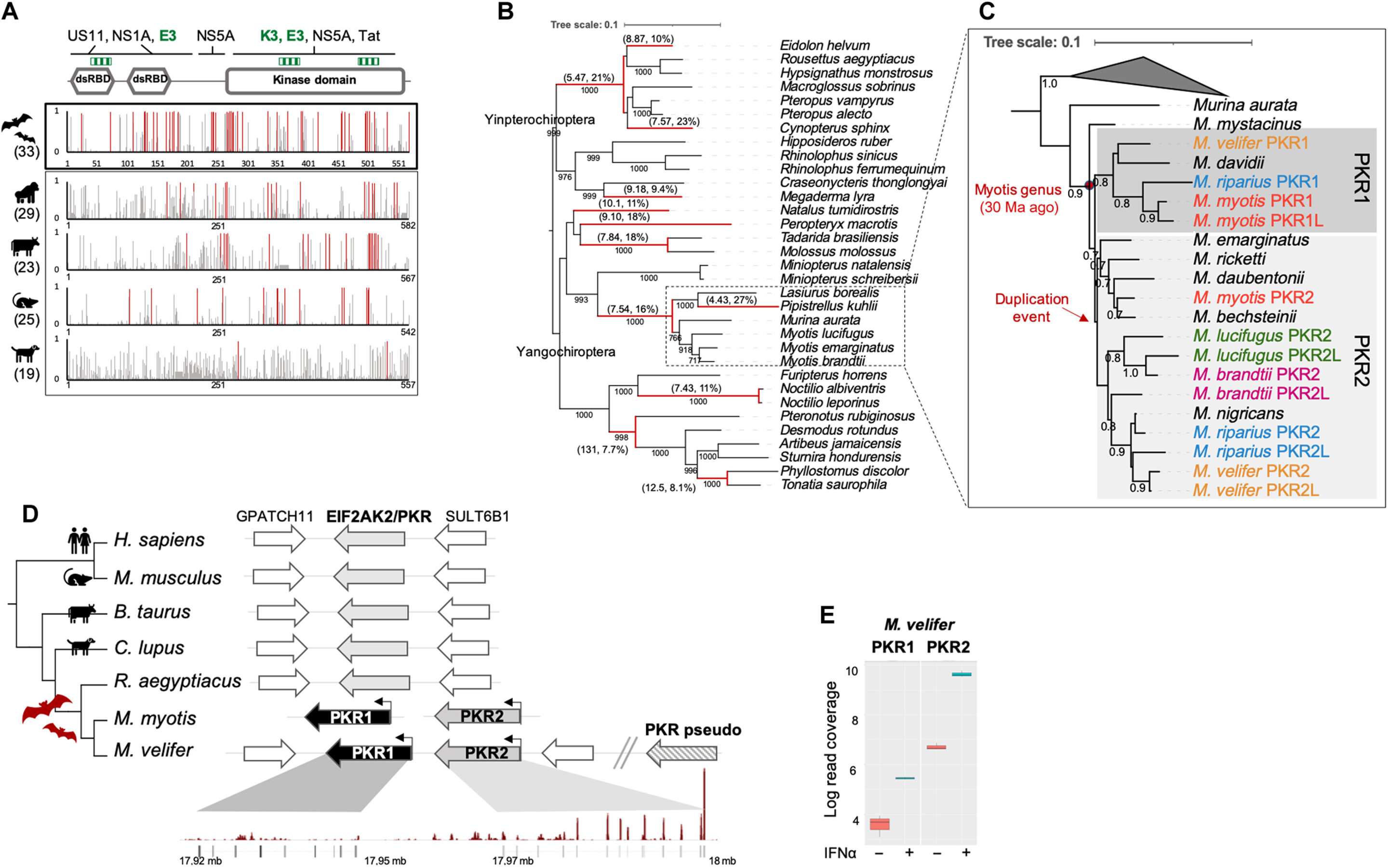#Researchers find repeated gene duplications and genetic diversification in protein kinase R in mouse-eared bats

Table of Contents
“Researchers find repeated gene duplications and genetic diversification in protein kinase R in mouse-eared bats”
![PKR has been the target of strong diversifying positive selection and original duplication in bats.(<b>A</b>) Sites under positive selection in mammalian protein kinase R (PKR). Graphic panels represent the posterior probabilities of positive selection [Bayes empirical Bayes (BEB)] (<i>y</i> axis) in the M2 model (ω > 1) for each codon (<i>x</i> axis). Red bars indicate sites with BEB of >0.95. Numbers in brackets are the total species analyzed. Viral antagonists: Herpes virus US11, influenza A (IAV) virus NS1A, poxvirus E3 and K3 (green striped boxes), hepatitis C virus (HCV) NS5A, and human immunodeficiency virus Tat, reported to directly interact with PKR. (<b>B</b>) Maximum likelihood phylogeny of bat PKR indicating the branches under positive selection (<i>P</i> < 0.05, in red). Brackets, estimated values of ω and the proportion of sites under positive selection. Scale bar, number of substitutions per site. (<b>C</b>) Maximum likelihood phylogeny of <i>Myotis</i> PKR paralogous transcripts, with <i>Murina aurata</i>, <i>E. fuscus</i>, <i>Lasiurus borealis</i>, and <i>Pipistrellus kuhlii</i> as outgroups (collapsed for visualization). PKR1L and PKR2L may be paralogs or splicing variants of PKR1 and PKR2, respectively. Colors indicate the duplicated PKRs isolated from one individual. Bootstrap values of ≥0.7 are shown. Scale bar, number of substitutions per site. (<b>D</b>) Canonical locus of <i>EIF2</i>A<i>K2</i>/PKR in mammals. The <i>EIF2AK2</i> genes (black and gray arrows), the <i>EIF2AK2</i> pseudogene (striped arrow), and the adjacent genes (white arrows) are shown. The genomic coordinates are indicated. (<b>E</b>) Expression pattern of PKR paralogs upon basal and IFNα treatment of <i>M. velifer</i> fibroblasts. Boxplots represent the number of reads in log<sub>10</sub> scale for each condition and PKR copy (for exons found in both genes). Credit: <i>Science Advances</i> (2022). DOI: 10.1126/sciadv.add7540 Researchers find repeated gene duplications and genetic diversification in protein kinase R in mouse-eared bats](https://scx1.b-cdn.net/csz/news/800a/2022/researchers-find-repea.jpg)
An international team of researchers has found evidence of repeated genomic duplications and genetic diversification in protein kinase R (PKR) in mouse-eared bats. In their paper published in the journal Science Advances, the group describes their genomic study of multiple species of mouse-eared bats and their sequencing of 15 of them.
Prior research has shown that bats can harbor many viral infections that do not harm them—it is one of the reasons they have been fingered as a vector for viruses that jump to other animals and/or humans. In this new effort, the researchers sought to learn more about why bats are able to go unharmed when infected with viruses that harm most other mammals.
The work by the team focused primarily on PKR—a protein that is encoded by the EIF2AK2 gene. Prior research has shown that it is an important part of immune responses to viruses in mammals. To learn more about how it operates in bats as compared to other mammals, the researchers looked at gene sequences of 33 species of mouse-eared bats.
They focused most specifically on differences in EIF2AK2, which result in differences in PKR, which in turn represent different virus-fighting abilities. The team also sequenced the genomes of 15 of the species to gain a larger perspective of the role EIF2AK2 has played in mouse-eared bat history.
The researchers found evidence of what they describe as an arms race between EIF2AK2 and various viruses. And as part of that arms race, at one point, a duplication appeared. EIF2AK2 began appearing twice in the genome, which allowed for making two different kinds of PKR in every bat they studied. And the two versions did not just double up on virus killing; they were slightly different, allowing the bat hosting them to combat a virus in two ways. And that, the researchers suggest, is likely why bats are able to harbor viruses without becoming sick.
The researchers also found some species that had more than two copies of EIF2AK2, and in some cases, other genes that were very similar to EIF2AK2. In either case, it likely makes the bats even more able to fight viruses. They also noted that such duplications are thus far found only in bats.
Stéphanie Jacquet et al, Adaptive duplication and genetic diversification of protein kinase R contribute to the specificity of bat-virus interactions, Science Advances (2022). DOI: 10.1126/sciadv.add7540
© 2022 Science X Network
Citation:
Researchers find repeated gene duplications and genetic diversification in protein kinase R in mouse-eared bats (2022, November 25)
retrieved 25 November 2022
from https://phys.org/news/2022-11-gene-duplications-genetic-diversification-protein.html
This document is subject to copyright. Apart from any fair dealing for the purpose of private study or research, no
part may be reproduced without the written permission. The content is provided for information purposes only.
If you liked the article, do not forget to share it with your friends. Follow us on Google News too, click on the star and choose us from your favorites.
For forums sites go to Forum.BuradaBiliyorum.Com
If you want to read more Like this articles, you can visit our Science category.




